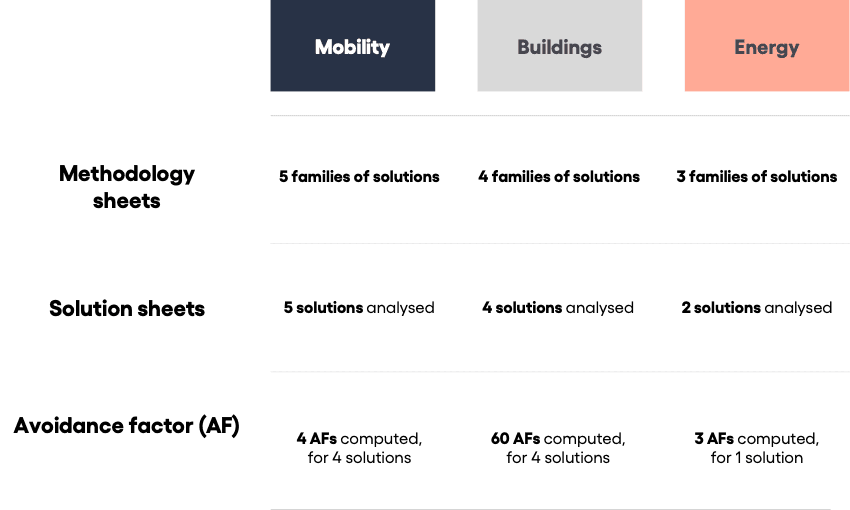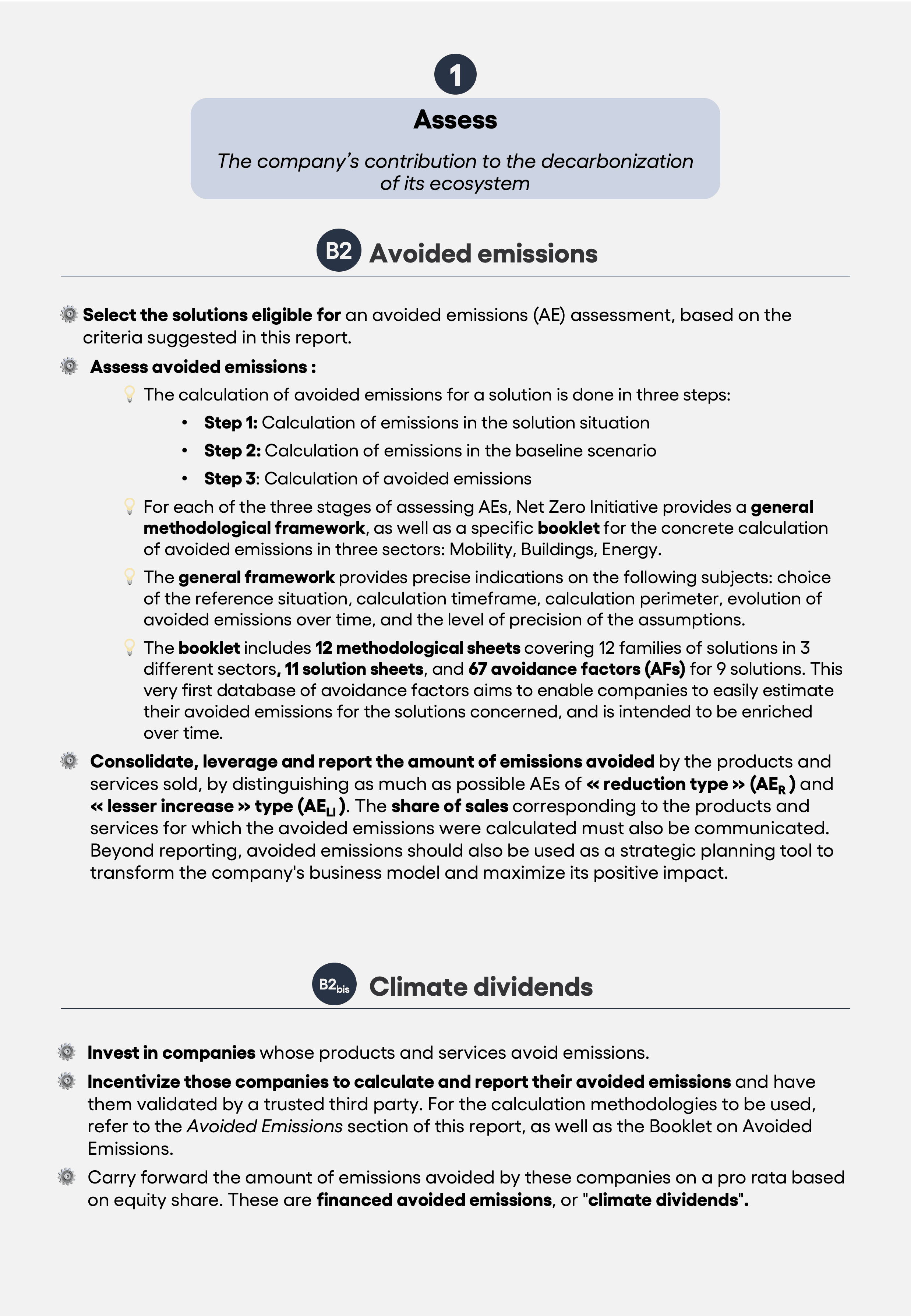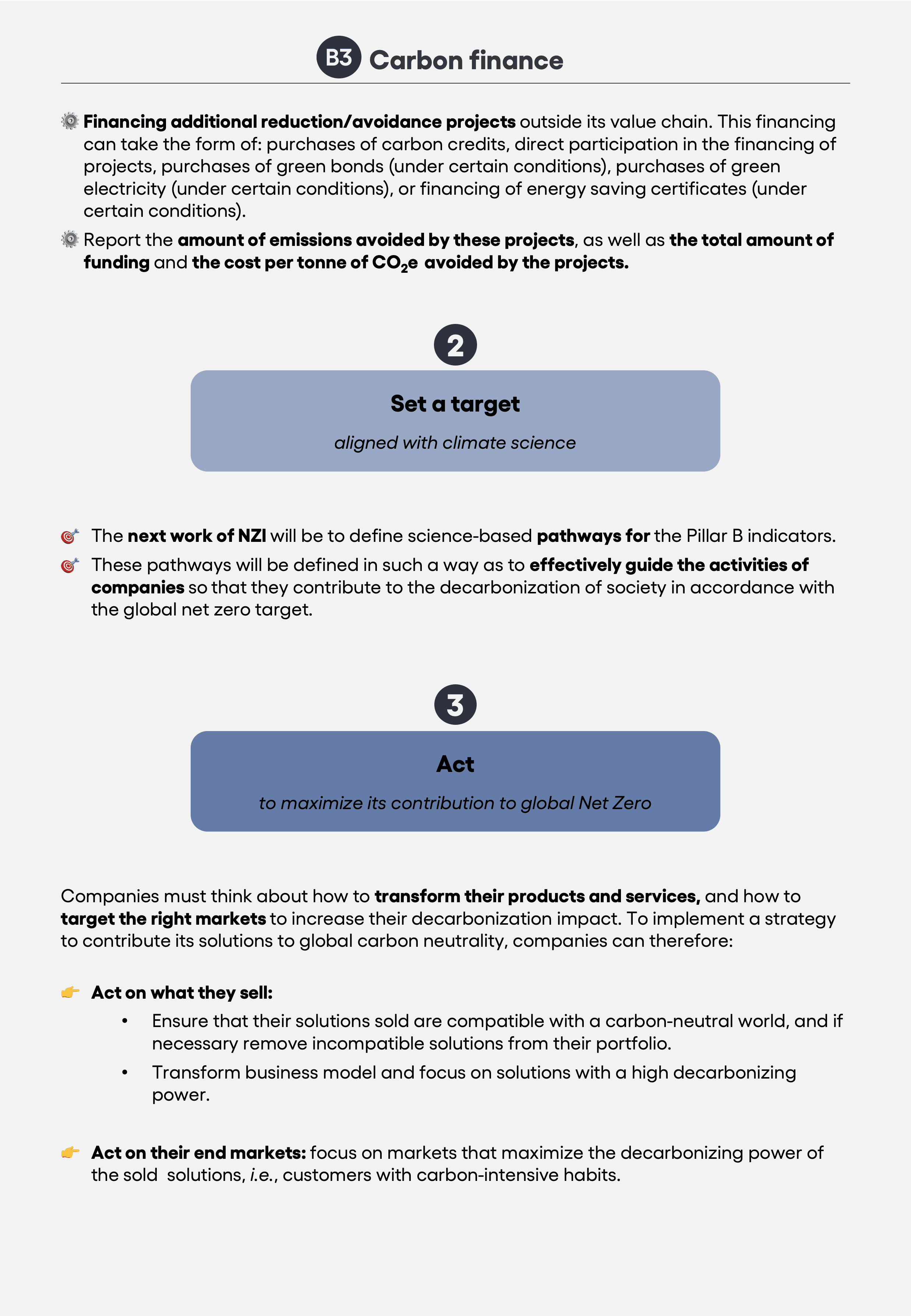Net Zero Initiative - The pillar B guide
Calculating and leveraging avoided emissions
As part of the third season of the Net Zero Initiative project (2021-2022), Carbone 4 and its partners had the opportunity to explore in depth the concept of the contribution of companies to the decarbonization of their ecosystem. This work has led to two key documents:
- The Pillar B Guide - Calculating and leveraging avoided emissions, which aims to provide organizations with tools to calculate their various contributions to decarbonization (emissions avoided by products and services, climate dividends, carbon finance)
- The proposal to create a new climate indicator, which aims to assess the products and services's compatibility with the the Paris Agreement's objectives
Executive summary
This document is the guide to understanding the second pillar of the NZI dashboard, also referred to as pillar B. Pillar B is aimed at quantifying a firm’s positive impact on the greenhouse gas emissions of its ecosystem. It is composed of two major families:
- B2: how the company's solutions contribute to decarbonization,
- B3: the company's financial contribution to projects to reduce emissions outside its value chain.
B2) Contribution of solutions: avoided emissions
For the first family, this guide offers:
- A general methodological framework for calculating and reporting avoided emissions generated by corporate solutions;
- A toolbox containing:
- Detailed methodologies for calculating avoided emissions for three economic sectors: Mobility, Construction and Energy;
- Quantified applications for certain solutions in France: Avoidance Factors (FEv) to quickly estimate avoided emissions.
Synthesis of the general methodological framework
- Conceptual framework: avoided emissions are the difference between emissions in a reference situation and emissions in a situation with a decarbonizing solution. The emissions in these two situations depend on the context in which the solution is implemented: geography, client profiles, market segments, etc.
- Choice of reference situation: two main types of reference situations have been identified - the previous situation and the average of the market context. Net Zero Initiative describes a typology of contexts that enables the identification of a robust reference situation for a given context.
- Timeframe: Avoided emissions are calculated for the entire lifespan of the solution sold by the company. It is possible to update the calculation annually by using the input data corresponding to the year of calculation.
- Perimeter: The calculation of avoided emissions is done according to a life-cycle rationale: emissions from production, utilization, end of life, etc. have to be taken into account.
- Evolution of emissions though time: The projected decarbonization of energy and other dynamic effects must be taken into account in the calculations.
- Precision level of hypotheses: the calculation of avoided emissions may have varying levels of precision: specific to each solution sold, company average, or market average. The level of precision depends particularly on the type of solution and the availability of data.
Synthesis of the content of the toolbox
The toolbox compiles the findings of sector-specific methodological research. Three sectors are covered in the present report: Mobility, Construction and Energy.
The toolbox provides sector-specific methodological sheets on avoided emissions for each solution/context pair. For certain solutions, it also provides detailed methodological sheets and the first generation of Avoidance Factors (AFv) in France.
B3) Financial contribution beyond the value chain
The guide proposes a method for reporting additional avoided emissions generated by financing projects outside the company's value chain.
Building your pillar B strategy
Implementing a strategy that contributes to global net zero via the decarbonization of your ecosystem (Pillar B) can be broken down into three steps, similar to the process used to decarbonise your activities (Pillar A).
The first step consists of:
- calculating avoided emissions generated by solutions sold by the company, by placing emphasis on the solutions most compatible with the global goal of 1.5°C. This diagnosis allows us to answer the following question: to what extent do the solutions that I sell help my clients to reduce their emissions?
- calculating avoided emissions generated by the company's investments, that is to say the avoided emissions related to its investments. Climate dividends are the mirror image of category 3.15 of pillar A (emissions linked to investments) for pillar B avoided emissions.
- evaluating the company's financial contributions to additional projects that avoid emissions or reduce them outside its value chain.
The three categories of avoided emissions – by the products and services sold, by investments and by financing projects outside the value chain – must be reported separately.
The second step consists of setting a target for the indicators measured in the first step. This step allows us to answer the following question: What is the right level of climate performance that my pillar must reach to ensure my contribution to carbon neutrality is in line with science?
Finally, the third step consists of orienting your business model, financing and investing to reach the targets set. This step allows us to answer the following question: How can I act to maximise my positive impact in terms of the decarbonization of my ecosystem?
This report focuses on the first step, but already provides some ideas for action on the following steps. In the short term, the Net Zero Initiative plans to enrich its framework with concrete recommendations on each of these two stages.
Contributors
Carbone 4 team
Maxime Aboukrat, Consultant, Rodrigo Baranna, Project leader, Antoine Crépel, Consultant, Julie Daunay, Principale, co-manager of the Carbon Neutrality team, César Dugast, Manager, co-manager of the Carbon Neutrality team, Jean-Marc Jancovici, founding partner
External contributors
Fanny Fleuriot (ADEME), Yann Rosetti (ADEME), Aldo Diaz Sanchez (Alstom), Cécile Texier (Alstom), Thomas Farfal (Bouygues), Margaux Lignel (Bouygues), Thibaut Abergel (Bouygues), Emmanuel Cibla (Decathlon), Louis Fresel (Decathlon), Thibaut Brac de la Perriere (EDF), Anne Grau (EDF), Meleika Hounsou (ENGIE), Anne Prieur-Vernat (ENGIE), Clément Tremblay (ENGIE), Clément Machon (Fifteen), Christophe Delfeld (GRTgaz), Pascale Guillo-Lohan (GRTgaz), Gaël Pognonec (GRTgaz), Laeticia Dietrich (Hager), Chloé Cibulka (LVMH), Hélène Valade (LVMH), Bénédicte Barbry (Mobivia), Anne-Danièle Fortunato (Norauto), Jean-Manuel Canet (Orange), Philippe Tuzzolino (Orange), Nadia Aitamar (Poste Immo), Nora Oulakrouz (Poste Immo), Aurélia Menacer (RATP), Daniele Bufano (Schneider Electric), Esther Finidori (Schneider Electric), Caroline Van Renterghem (Smoove), Claire Rousselet (SNCF), Noé Bernabeu (Somfy), Julie Durepaire (Somfy), Philippe Geoffroy (Somfy), Céline Pigeon (Somfy), Mehdi Coly (Time for the Planet), Léa Degardin (Via ID).
Sponsor organizations
ADEME, Alstom, Bouygues, Decathlon, EDF, ENGIE, GRTgaz, Hager, LVMH, Mobivia, Nature et Découvertes, Orange Groupe, Poste Immo, RATP, Schneider Electric, SNCF, Somfy, Suez, Tikamoon, Time for the Planet, Unima, URW.
The team is grateful for the experts of the scientific committee who contributed to this guide.
Page layout
Louise Badoche (Carbone 4)





















